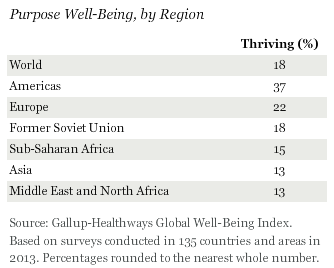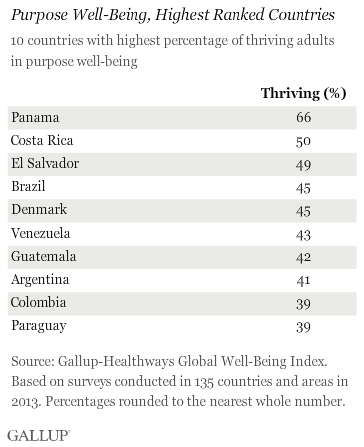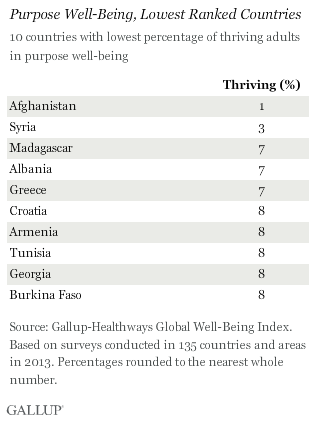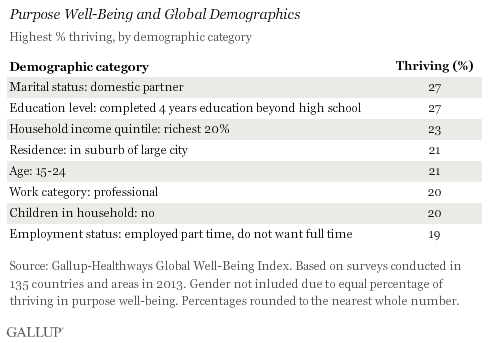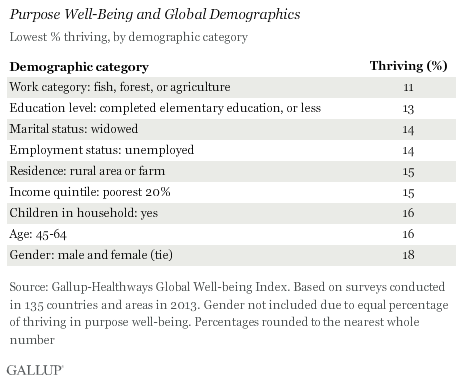WASHINGTON, D.C. — Fewer than one in five adults worldwide can be considered thriving — or strong and consistent — in levels of purpose well-being, as measured by the inaugural Gallup-Sharecare Global Well-Being Index in 2013. Residents living in the Americas are the most likely to be thriving in this element (37%), while those in Asia and the Middle East and North Africa are the least likely (13%).
The Global Well-Being Index measures each of the five elements of well-being — purpose, social, financial, community, and physical – through Gallup’s World Poll. Purpose well-being, which is defined as people liking what they do each day and being motivated to achieve their goals, was the lowest performing element of the five elements of well-being. Global results of how people fare in 135 countries and areas in this element, as well as the four other elements, have been compiled in the State of Global Well-Being report.
Latin Americans Have Highest Purpose Well-Being
Nearly all the countries with the highest thriving rates of purpose well-being in the world are in Latin America. Culture may play a role in these perceptions — Latin Americans generally report higher levels of positive daily emotions and have a better outlook on the job market than any other regional group. Denmark was the sole non-Latin American country in the top 10 countries with the highest percentage of the population that is thriving in purpose well-being.
Panama led the world in four of the five well-being elements — including purpose well-being. Two in three Panamanian adults were thriving in purpose well-being. Panama’s strong and growing economy with an unemployment rate of 4.5% in 2013, coupled with investments in national development could be contributing to these high levels of thriving in well-being. Neighboring Costa Rica followed at 50%, despite relatively high unemployment for the region — nearly 9% in the third quarter of 2013.
Struggling Economies and Conflict Zones Dominate Low Purpose Well-Being
Asia and the Middle East and North Africa performed worst in purpose well-being, with only 13% of adults in these regions thriving in this element. However, when looking at adults’ perceptions at the country level, trends among countries emerge and the lowest percentages appear to be associated with conflict zones and countries with poor economic performance.
Afghanistan and Syria struggled most in this element and had the lowest levels of purpose well-being, with 3% or less of adults thriving in this element. These two countries along with Tunisia, and to a lesser extent, Armenia, are embroiled in armed conflicts, which have disrupted daily lives and prevented portions of the population from carrying out normal functions.
Poor economies may also have affected purpose well-being. With only 7% of the population thriving in purpose, Greece is grappling with an economy that has yet to recover from the European debt crisis. Croatia has also suffered negative GDP growth since 2009 and high unemployment rates compared with Western European countries.
High Purpose Well-Being Influenced by Demographics of Education, Wealth, and Youth
Worldwide, demographics play a role in the likelihood that people are thriving in purpose well-being. Those who were in domestic partnerships or who had completed four years of education beyond high school were more likely to be thriving in purpose well-being (27%) than the global population as a whole (18%).
The wealthiest quintile, urban residents, the young, and office workers were also more likely to be thriving than their poorer, more rural, older, or non-office worker counterparts. Globally, however, there was no difference in the level of thriving between men and women. Eighteen percent of each were thriving in this element.
Certain Employment Sectors and Less-Educated Have Low Purpose Well-Being
Globally, adults who were employed in the fishing, forestry, and agriculture sectors were the least likely group to be thriving in purpose well-being, with 11% of respondents providing responses that placed them in this category. Those with an elementary education or less followed at 13%.
The only region where education levels did not significantly affect people’s likelihood to thrive in purpose well-being was the Middle East and North Africa region, where 14% of those who have completed at least four years of education beyond high school are thriving in purpose, matching the 14% whose education did not go beyond the high school and tertiary level. In every other region surveyed, more highly educated respondents were significantly more likely to be thriving in purpose well-being than their less-educated counterparts in this element.
Women were significantly less likely to be thriving in purpose well-being (16%) than their male counterparts (20%) in former Soviet Union countries. The Americas saw women (36%) with slightly lower levels of purpose well-being thriving rates than their male counterparts (38%). There were no differences between genders in any of the remaining regions.
Implications
Purpose well-being is high when people like what they do each day and are motivated to achieve their goals. This is true whether they work for a company, are self-employed, care for family members, pursue education, work on a farm, or engage in charity work. Those with high well-being in this element also tend to be highly engaged in their work. They are emotionally invested in what they do and focus on creating value through their efforts.
When people are unable to find work or achieve other personal measures of success and well-being with respect to their purpose, it can impact areas beyond the individual and affect society as a whole. Such conditions fed the Arab Spring uprisings and fueled protests in European countries that enacted severe austerity cuts. In Panama, residents who have high purpose well-being (66% thriving) were more than twice as likely (at 37%) to have donated money to charity in the last year than were Mexicans (16%), whose purpose well-being level was only at a 33% thriving rate.
“It is important for any stakeholder who is interested in improving the health of their population including governments, community leaders, employers, insurers and other international organizations to understand the impact that purpose well-being has on overall well-being,” says Peter Choueiri, President, Sharecare International. “Our research shows that purpose well-being has a high correlation with social, financial, community, and physical well-being. In other words, investments in purpose well-being improvement will likely also lift the other elements of well-being resulting in lower medical costs and an improvement in productivity across whole populations.”
SURVEY METHODS
Results for the Gallup-Sharecare Global Well-Being Index are based on telephone and face-to-face interviews on the Gallup World Poll, with a random sample of approximately 133,000 adults, aged 15 and older, living in 135 countries and areas in 2013.
For results based on the total sample of national adults, the margin of sampling error is less than ±1 percentage point at the 95% confidence level. For results based on country-level samples, the margin of error ranges from a low of ±2.1 to a high of ±5.3.
All country-level analyses use country weights. Global and regional analysis uses projection weights that account for country size. Minimum sample sizes of N=300 apply.
In addition to sampling error, question wording and practical difficulties in conducting surveys can introduce error or bias into the findings of public opinion polls.
Each element in the Global Well-Being Index contains two questions asked of all respondents:
Purpose
- You like what you do every day.
- You learn or do something interesting every day.
Social
- Someone in your life always encourages you to be healthy.
- Your friends and family give you positive energy every day.
Financial
- You have enough money to do everything you want to do.
- In the last seven days, you have worried about money.
Community
- The city or area where you live is a perfect place for you.
- In the last 12 months, you have received recognition for helping to improve the city or area where you live.
Physical
- In the last seven days, you have felt active and productive every day.
- Your physical health is near-perfect.
This article is the second of three articles exploring worldwide perceptions of well-being in the five well-being elements measured in the Gallup-Sharecare Global Well-Being Index: purpose, social, financial, community, and physical.
